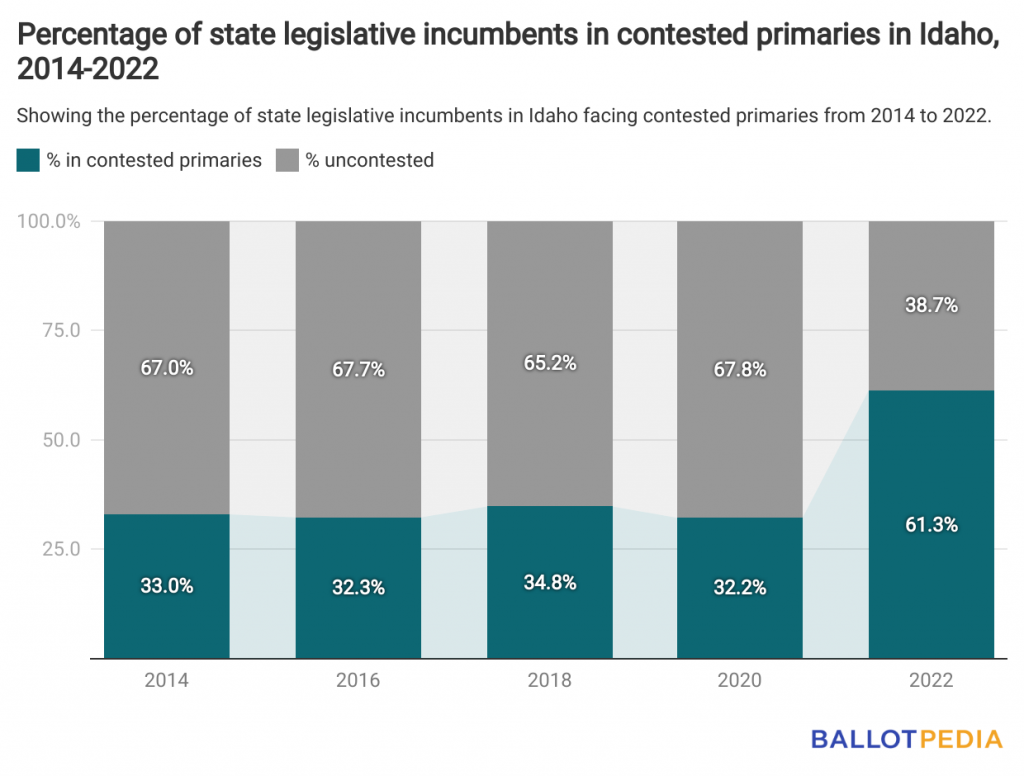More state legislative incumbents are facing primary challenges in Idaho this year than at any point since at least 2014. Seventy-five incumbents are seeking re-election this year, 61.3% of whom (46) are running in contested primaries. From 2014 to 2020, the percentage of incumbents in contested primaries hovered at around half that rate ranging from 32 to 34%.

Of those 46 incumbents in contested primaries, 45 are Republicans, and one—Rep. James Ruchti—is a Democrat.
Redistricting is a partial cause of this increase. When states redraw district lines, they can change so that incumbents who previously represented one district now live within the district lines of another. This can result in incumbents challenging other incumbents in contested primaries or general elections if they choose to seek re-election.
There are four such incumbent vs. incumbent primaries this year:
- House District 9B: Rep. Scott Syme (R), first elected to District 11A in 2016, will face Rep. Judy Boyle (R), first elected in 2008.
- House District 22A: Rep. Greg Ferch (R), first elected to District 21B in 2020, will face Rep. John Vander Woude (R), first elected in 2010.
- Senate District 9: Sen. Jim Rice (R), first elected to District 8 in 2012, will face Sen. Abby Lee (R), first elected in 2014. Two other candidates are running in this primary.
- Senate District 14: Sen. Steven Thayn (R), first elected to District 8 in 2012, will face Sen. C. Scott Grow (R), first appointed in 2018. One other candidate is running in this primary.
For the purposes of our analysis, all eight of these incumbents are considered incumbents in contested primaries.
Looking beyond incumbents in contested primaries, the total number of primaries also increased this year to its highest level compared to previous cycles, driven entirely by an increase in Republican contests.

These figures come from Ballotpedia’s analysis of post-filing deadline competitiveness statistics. The filing deadline for candidates running for state or federal office in Idaho this year was March 11. Candidates filed to run for the state’s 35 Senate and 70 House seats.
Here are some other highlights from this year’s filings:
- Of the 105 seats up for election, 32.3% are open, meaning no incumbent is in the running. This is the largest percentage of open seats since at least 2014. Newcomers are guaranteed to win these open seats, meaning at least one-third of the Idaho Legislature will be new to their seats in the 2023 legislative session.
- Of the 105 seats up for election, 32.3% are open, meaning no incumbent is in the running. This is the largest percentage of open seats since at least 2014. Newcomers are guaranteed to win these open seats, meaning at least one-third of the Idaho Legislature will be new to their seats in the 2023 legislative session.
- Of the 105 seats up for election, 32.3% are open, meaning no incumbent is in the running. This is the largest percentage of open seats since at least 2014. Newcomers are guaranteed to win these open seats, meaning at least one-third of the Idaho Legislature will be new to their seats in the 2023 legislative session.

Republicans currently hold a 28-7 majority in the state Senate and a 58-12 majority in the state House. With a Republican governor, Idaho is one of 23 Republican trifectas.
Idaho’s state legislative primaries are scheduled for May 17, making them the sixth in the nation.
Additional reading:
Learn More






